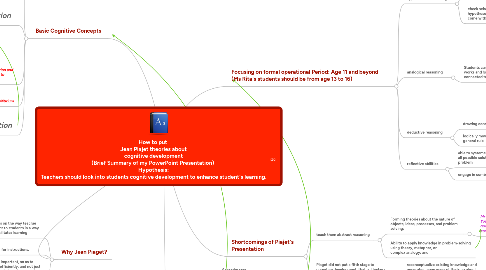
1. Basic Cognitive Concepts
1.1. Schema
1.1.1. It is mental structures that allow each of us to "understand" or create meaning out of our experiences
1.1.2. This facilitates our cognitive adaptation to those experiences
1.2. Assimilation
1.2.1. It is the progress of integrating new perceptual, motor, or conceptual material or experiences into an existing schema (mental structures)
1.2.2. This is bridged out to three processes
1.2.2.1. Accretion
1.2.2.1.1. concrete understanding of knowledge is remembered in the schema
1.2.2.2. Tuning
1.2.2.2.1. Existing knowledge are modified through experience
1.2.2.3. Restructuring
1.2.2.3.1. The creation of new knowledge to replace obsolete knowledge. (updating)
1.3. A balance of Assimilation and Accomodation equals to Equilibration
1.3.1. The child has to know how to "accrete, tune, and restructure" their schema, and not just to keep on building new schemas like in "accomodation"
1.3.1.1. This results to confusion for the many schemas built, or cognitive conflict.
1.4. Cognitive Disequilibrium
1.4.1. Students will attempt to come to an understanding of the situation that has caused the conflict and assimilate new experiences into existing schemata or new schemata
1.4.1.1. hypothesizing how the experience is accomplished
1.5. Accomodation
1.5.1. A new schema will develop in order to adapt to these new and unique experiences
2. Why Jean Piaget?
2.1. Jean Piaget concerns on the way teacher communicate content to students in a way that it induces or facilitates learning
2.2. For example in business, companies spend years of research on how to understand their clients to succeed. SImilar to teachers, teachers have to understand their student's physical, cognitive and social development needs in order to make plans for instructions.
2.3. This is important, so as to teach efficiently, and not just to deposit knowledge to the students without understanding
3. Four Stages
3.1. Sensorimotor
3.2. Preoperational
3.3. Concrete Operational
3.4. Formal Operational
4. Focusing on formal operational Period: Age 11 and beyond (Ms Rita's students should be from age 13 to 16)
4.1. hypothetical reasoning
4.1.1. ability to plan several alternative hypotheses in dealing with a problem
4.1.1.1. Joel answered: Tsunamis are caused by high atmospheric pressure!
4.1.2. check schema against each of the hypotheses to generate possibilites to come with an appropriate decision
4.1.2.1. Ms Rita: "And Aisha, … she usually reads up before the lesson, said that it’s due to volcanic eruptions but could not elaborate."
4.2. analogical reasoning
4.2.1. Students can fully explained how analogy works and how each part of the analogy is connected to the other
4.2.1.1. However, teachers needs to make sure that she fully explains the analogy then students to explain the analogy themselves.
4.2.1.1.1. Ms Lim: Yeah. That was pretty close. You could have used guiding questions to lead her further.
4.2.1.1.2. Ms Rita: Come on, Ms Lim, they are sec 2 students, they should know all these general knowledge.
4.2.1.1.3. Ms Rita: Haven’t they heard of the 2004 tsunami catastrophe? I don’t think they understood my explanation either.
4.3. deductive reasoning
4.3.1. drawing conclusions
4.3.1.1. by applying rules
4.3.2. logically moving from a general rule
4.3.2.1. to solutions
4.4. reflective abilities
4.4.1. able to systematically generate all possible solutions to a problem
4.4.2. engage in combinatorial reasoning
5. Shortcomings of Piajet's Presentation
5.1. teach them abstract reasoning
5.1.1. Forming theories about the nature of objects, ideas, processes, and problem solving;
5.1.1.1. Mr Yeo: You’ve asked the right person. You must give them higher order thinking questions like letting them compare and contrast.
5.1.2. Ability to apply knowledge in problem-solving using theory, metaphor, or complex analogy; and
5.2. Piaget did not put a fifth stage to cognitive development, that is, thinkers like Piaget himself or Einstein
5.2.1. reconceptualize existing knowledge and generate unique ways of thinking about the world
